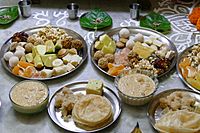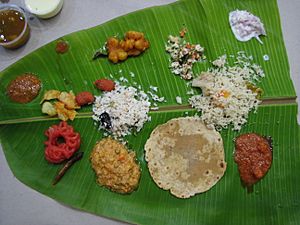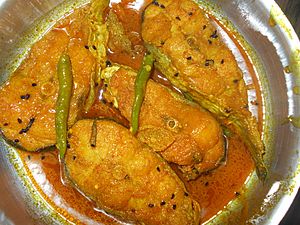Diet in Hinduism facts for kids
The way people eat in Hinduism can be very different, depending on their traditions. Hindu holy books don't strictly say if people should eat meat or not. However, some of these books suggest that eating only vegetables is best. This idea comes from a belief called ahimsa, which means being kind and not hurting any living thing. A survey by Pew Research Center found that about 44% of Hindus say they are vegetarian.
Contents
History of Hindu Diet
Long ago, in the Indus Valley civilisation, people ate a lot of meat from animals like cattle, buffalo, goats, pigs, and chickens. This continued for a long time during the Vedic period.
Later, after the Vedic period, new religions like Jainism and Buddhism became popular. These religions taught about non-violence. Because of their influence, many Brahmins (a group of Hindu priests and scholars) stopped sacrificing animals and started eating only vegetables. Today, about 33% of all Hindus are vegetarians.
Diet in Hindu Holy Books
Hindu holy books talk a lot about food and what people should eat.
The Vedas
The Vedas are some of the oldest Hindu scriptures. They show that people in ancient times ate grains like barley and rice, beans like urad and moong, vegetables like lotus roots, and milk products from cows, buffaloes, and goats.
The Vedas also mention that animals like bulls, horses, and goats were sacrificed and eaten. Even though cows were highly respected, some barren cows were also sacrificed. However, the word aghnyā, meaning 'not to be eaten' or 'inviolable', is used for cows many times in the Vedas. This shows that some people thought cows should not be harmed.
Some experts believe that meat might have been eaten only during special religious ceremonies, not every day. Even in the older Vedas, there were signs that people felt uneasy about the "gory brutality of sacrificial butchery." The idea of ahimsa (non-violence) towards animals first appears in a moral sense around 800 BCE. Later texts, like the Shatapatha Brahmana and the Chāndogya Upaniṣad, started to speak against eating meat and killing "all living entities."
Dharmaśāstras
The Dharmaśāstras are ancient Hindu texts about rules and duties. They say that when you are about to eat, you should respect the food and never speak badly about it.
These texts also advise people not to cook only for themselves. Instead, they should offer food to gods, ancestors, other people (as hospitality), and to monks or those in need. They teach that all living things depend on food, so food should be respected and handled with care. When you see food, you should show respect, perhaps by folding your hands and saying a prayer of thanks.
Hindu monks and ascetics (people who live a very simple life for spiritual reasons) take this respect for food even further. They believe that getting and preparing food often involves harming other living things or nature. So, they try to avoid starting this process themselves. They often rely on begging for leftover food from householders. If they can't find leftovers, they might look for fallen fruit or seeds left in fields after harvest.
Forest hermits, another type of Hindu ascetic, don't even beg for leftovers. They eat only wild, uncultivated food like fruits, roots, and leaves that grow naturally in the forest. They try to live a life that causes the least possible harm to any living thing.
The Manusmriti
The Manusmriti is an important Hindu law book. It talks about diet in chapter 5. It has verses that strongly discourage eating meat. For example, it says:
You can never get meat without hurting living beings... so you should avoid meat. Thinking about how meat is gotten and how creatures are tied up and killed, you should stop eating any kind of meat... The person who allows it, the person who butchers, the person who kills, the person who buys or sells, the person who cooks, the person who serves, and the person who eats – all of them are killers. There is no worse sinner than someone who wants to make their own body strong by eating someone else's flesh, unless it's for an offering to gods or ancestors.
However, the Manusmriti also says that eating meat is okay in certain situations. For example, if not eating meat would put a person's health or life at risk. It also mentions that meat can be eaten if it's part of a sacrifice. It even approves of fish and meats from deer, antelope, poultry, goats, sheep, and rabbits for sacrificial meals.
Experts say that the Manusmriti shows that ancient Hindus had different ideas about eating meat. But there was a growing belief that people should avoid harming living things and move towards a vegetarian lifestyle.
The Mahabharata
The Mahabharata is another very important Hindu epic. It has many stories that praise non-violence towards animals. It strongly speaks against killing animals. For example, the character Bhisma says that kindness is the highest religious principle. He compares eating animal meat to eating the flesh of one's own child.
The Mahabharata suggests that animal sacrifices were only introduced in a later, less pure age (the treta yuga). They were not present in the "golden age" (the sat yuga).
The Tirukkuṛaḷ
The Tirukkuṛaḷ is an ancient text from South India, written in the Tamil language. It says that eating in moderation is a good way to live. It also criticizes eating meat in its chapter on "abstinence from flesh." This text, written before 400 CE, emphasizes that eating too much can be bad for your health.
The Puranas
The Puranas are a collection of Hindu religious texts. They often strongly oppose violence against animals. The Bhagavata Purana says that not harming any living being is the highest duty. It teaches that the sin of harming animals cannot be washed away easily. It describes terrible consequences for those who harm animals.
The Skanda Purana states that wise sages were upset by animal sacrifice. They believed sacrifices should be done with grains and milk instead. It even says that sages chose to starve rather than kill animals during a famine.
Diet and Social Status
In some parts of Hindu society, vegetarian groups are sometimes seen as having a higher social status than non-vegetarian groups. Eating "clean" animals like goats and sheep might be seen as better than eating "unclean" animals like pigs. Eating animals that have been killed for food is also seen as better than eating animals that died naturally, as dead animals are considered impure.
Sanskritisation
Sanskritisation is a term that describes how lower social groups sometimes adopt the customs and practices of higher social groups to improve their own status. One such practice is becoming vegetarian. For example, some communities in Gujarat, India, adopted Vaishnavism (a branch of Hinduism) and became vegetarian. This was also seen in some groups in North India.
Modern Hindu Diet
Today, about 33% of Hindus are vegetarian. A 2021 survey by Pew Research Center found that 44% of Hindus say they are vegetarian.
Lacto-vegetarian Diet
Hinduism does not require everyone to be vegetarian. However, many Hindus choose not to eat meat because it helps them avoid hurting other living things. Vegetarianism is sometimes seen as a "satvic" lifestyle, which means it helps purify the body and mind.
Many Hindus prefer a lacto-vegetarian diet. This means they eat milk-based foods and all other foods that don't come from animals, but they avoid meat and eggs. There are three main reasons for this:
- The principle of non-violence (ahimsa) towards animals.
- The desire to offer only vegetarian food to their chosen deity and then receive it back as prasad (blessed food).
- The belief that non-vegetarian food is not good for the mind and for spiritual growth.
Many Hindus refer to scriptures like the Mahabharata, which says, "Nonviolence is the highest duty and the highest teaching," to support their vegetarian diet.
A common modern Hindu lacto-vegetarian meal usually includes grains like rice and wheat, beans, green vegetables, and dairy products. In some areas, flatbreads made from millet are also common. Hindus who follow this diet avoid any fat that comes from slaughtered animals.
Some Hindus, especially those who follow the Vaishnav tradition, avoid eating onions and garlic, either completely or during a specific period called Chaturmas (roughly July to November). In Maharashtra, some Hindu families also avoid eggplant dishes during this time. Groups like ISKCON (Hare Krishna) do not eat meat, fish, or fowl. Other groups, like the Pushtimargi sect and the Swaminarayan movement, also avoid certain vegetables like onion, mushrooms, and garlic, believing they are harmful to spiritual progress.
Non-vegetarian Diet
Hinduism does not forbid eating meat. While many Indian Hindus are non-vegetarians and eat eggs, fish, chicken, and other meats, a large number are still vegetarian. In some Hindu communities outside India, like in Suriname and Guyana, very few Hindus are vegetarian.
Hindus who eat meat often prefer poultry, fish, other seafood, goat, and sheep. In Eastern and coastal South-Western India, fish and seafood are common foods for many local communities. For economic reasons, even meat-eating Hindus in India might eat lacto-vegetarian meals most days, as meat can be expensive. India actually consumes the least amount of meat per person globally.
Hindus who eat meat usually do not eat beef. Cows are highly respected in Hindu belief and are seen as motherly, giving animals, almost like a family member. So, most Hindus avoid meat from cows. A small number of Nepali Hindu groups sacrifice buffalo at the Gadhimai festival, but they see buffalo as different from cows. However, buffalo sacrifice was banned at the Gadhimai Temple in 2015.
Some Hindus who eat non-vegetarian food choose to avoid it during festivals like Janmastami. In Bengal, however, goats are traditionally sacrificed during the Kali Puja festival. The cooked meat is offered to the deity and then eaten by devotees as prasad.
Prasad and Naivedya

Prasad is a religious offering in Hinduism. It is most often vegetarian food specially cooked for devotees after prayers and thanks to a deity. Mahaprasada is blessed food offered to the deity in a Hindu temple that is then shared by all devotees.
Prasad is related to Naivedya. Naivedya is the food offered to God, while Prasad is the sacred food that God has blessed and returned. In some cases, like for the deity Kali in Eastern India, Naivedya and Prasad can be non-vegetarian food from an animal like a goat that was sacrificed.
Diet on Hindu Festivals and Fasting Days
The Hindu calendar has many festivals and religious observations. Special dishes are often prepared for these occasions.
Festival Dishes
Hindus prepare unique dishes for different festivals. For example, Kheer and Halwa are two desserts made for Diwali. Puran poli and Gujia are prepared for Holi in various parts of India.
Diet on Fasting Days
Hindu people fast on certain days, such as Ekadashi (in honor of Lord Vishnu), Chaturthi (in honor of Ganesh), Mondays (in honor of Shiva), or Saturdays (in honor of Maruti or Saturn). Only specific foods are allowed during these fasting periods. These include milk and other dairy products like dahi, fruits, and starchy foods like sago, potatoes, sweet potatoes, amaranth seeds, nuts, and shama millet. Popular fasting dishes include Farari chevdo and Sabudana Khichadi.
Images for kids
See also
 In Spanish: Dieta en el hinduismo para niños
In Spanish: Dieta en el hinduismo para niños









